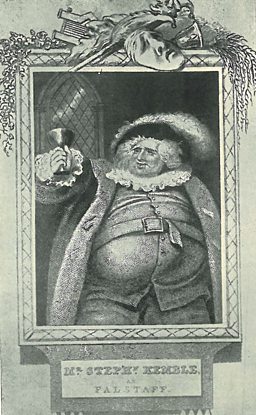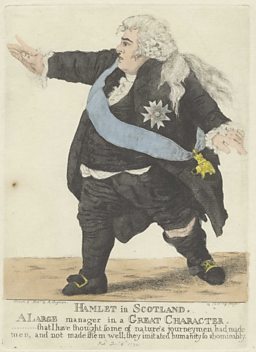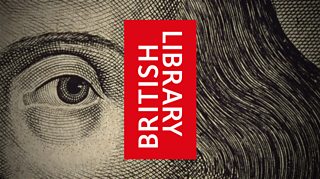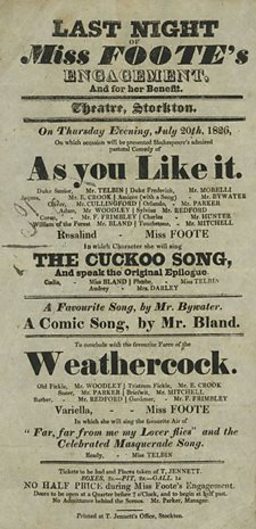Heavyweight Shakespearean actor's huge influence on north east theatre
Stephen Kemble was a member of the Shakespearean acting dynasty the Kembles - which included his sister Sarah Siddons – who went on to become a highly successful Northern theatre manager of the eighteenth century English stage.
His most famous acting role was in the part of the rotund Falstaff – for which he reportedly needed no padding as he apparently weighed 30 stone. He received acclaim in the role from the main London theatres of the day, but his heart lay in the Northern theatres, and he ran a Northern circuit from Newcastle’s Theatre Royal for a good 15 years, from 1791 to 1806.
-
![]()
Much ado near me
Hear more Shakespeare stories on BBC Newcastle
-
![]()
Shakespeare Festival 2016
The BBC celebrates the genius of the bard

These theatres included Alnwick, Stockton, Sunderland and North Shields, from where he supported the careers of rising stars of the time, many of whom had made their name acting Shakespeare such as his wife, the actress Elizabeth Satchell; Master Betty and Edmund Kean.
Kemble at the Theatre Royal, Newcastle
The Theatre Royal in Newcastle was awarded a royal patent by George III in 1787 and opened the following year with a performance of Shakespeare’s 'The Merchant of Venice'.
Kemble joined as manager a couple of years later and under his stewardship it quickly established itself as one of the country’s most prestigious theatres.
Kemble managed a dizzying array of smaller provincial theatres in his time – from Edinburgh, to Chester to Portsmouth.
The original Theatre Royal closed and was demolished to make way for the redevelopment of the city centre. If found a new home in Grey Street in 1837, long after Kemble’s death.
It still stands today of course, although having been completely refurbished inside following a major fire in 1899.

Stockton’s Georgian Theatre, Stephen Kemble and others
Stockton’s Georgian Theatre is the oldest Georgian provincial theatre in the country and a grade II listed building.
From its beginnings as a sixteenth century barn it became a theatre in 1766.
In 1798, Stephen Kemble took it on. Like Shakespeare, Kemble was an actor manager and his last performance on the stage of the Stockton, which became known as Oxford Road Playhouse, was in 1815. Fittingly, he signed off on his stewardship with his famous portrayal of Falstaff.
He died in 1822 aged 64 and is buried at Durham Cathedral.
From Kemble’s time onwards many famous artistes from London theatres, such as Drury Lane and the Lyceum, appeared in performances of Shakespeare and musical comedy. It is said that Junius Booth, the father of Wilkes Booth who was to assassinate President Lincoln, played with great success, as did Mrs Jordan, who was the mistress of the Duke of Clarence who later became King William IV.
By 1858 the appearances by big London stars had dwindled and the building was turned into a music hall.
It opened as the Theatre Royal in 1866 but closed less than a decade later. Gradually the building deteriorated until Stockton Council bought it for around £14,000.
The theatre was reborn as a community space, an event marked by the plaque on the outside of the building bearing the words ‘This stone commemorates the re-opening of the Georgian Theatre. Originally opened in 1766. Re-opened by Councilor Jim Cooke, Mayor. 29 April 1980'.
Today the building is managed by the Tees Music Alliance as a music and performance venue.

About Shakespeare on Tour
From the moment they were written through to the present day, Shakespeare’s plays have continued to enthral and inspire audiences. They’ve been performed in venues big and small – including inns, private houses and emerging provincial theatres.

BBC English Regions is building a digital picture which tracks some of the many iconic moments across the country as we follow the ‘explosion’ in the performance of The Bard’s plays, from his own lifetime to recent times.
Drawing on fascinating new research from Records of Early English Drama (REED), plus the British Library's extensive collection of playbills, as well as expertise from De Montfort University and the Arts and Humanities Research Council, Shakespeare on Tour is a unique timeline of iconic moments of those performances, starting with his own troupe of actors, to highlights from more recent times. Listen out for stories on Shakespeare’s legacy on your BBC Local Radio station from Monday 21 March, 2016.
You never know - you might find evidence of Shakespeare’s footsteps close to home…
Craig Henderson, BBC English Regions
-
![]()
Shakespeare Lives
The nation’s greatest performing arts institutions mark 400 years since the Bard's death
Related Links

Shakespeare on Tour: Around Newcastle
-
![]()
Child prodigy actor prepares to retire as he headlines in Newcastle
W.R. Grossmith says farewell to the stage at 11
-
![]()
Upstart actor plays Hamlet
Charles Young plays in Newcastle
-
![]()
The Royal Shakespeare Company's links with Newcastle
Nearly four decades of cooperation between Newcastle and the RSC
Shakespeare on Tour: Around the country
-
![]()
Ira Aldridge
Ira Aldridge - the first black Shakespearean actor
-
![]()
Blossoming at the Rose Theatre
Shakespeare, budding playwright and actor, at the Rose Theatre from the spring of 1592
-
![]()
Will Kemp dance finished in Norwich
Why did Will Kemp, Shakespeare's former clown, dance from London to Norwich?
-
![]()
London's Female Romeo
Charlotte Cushman, the American actress who took Victorian London by storm










